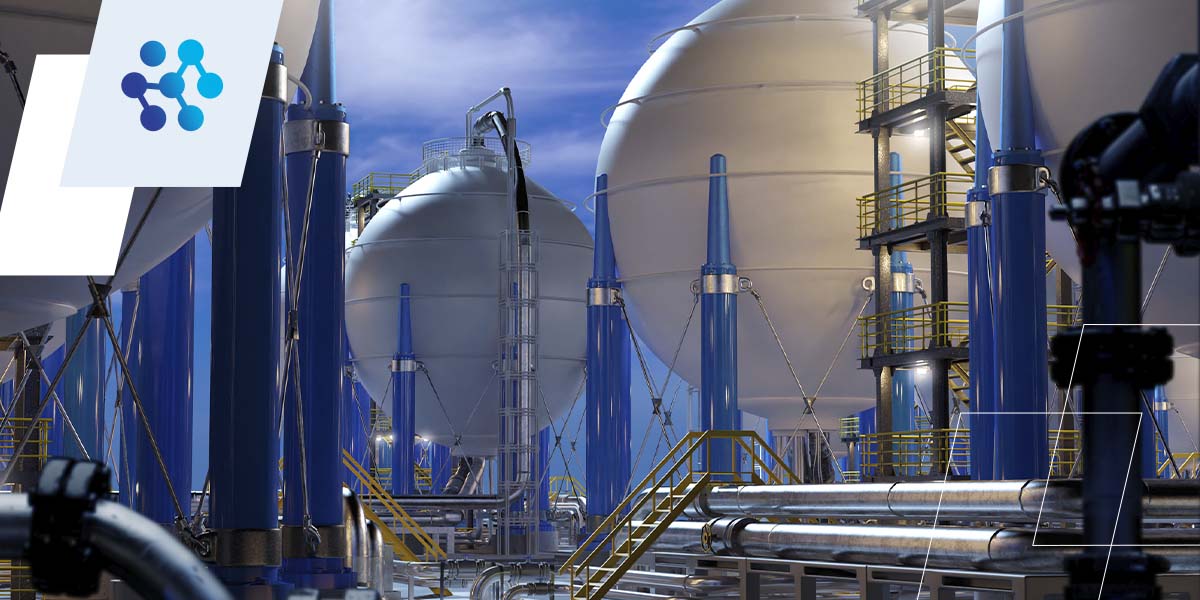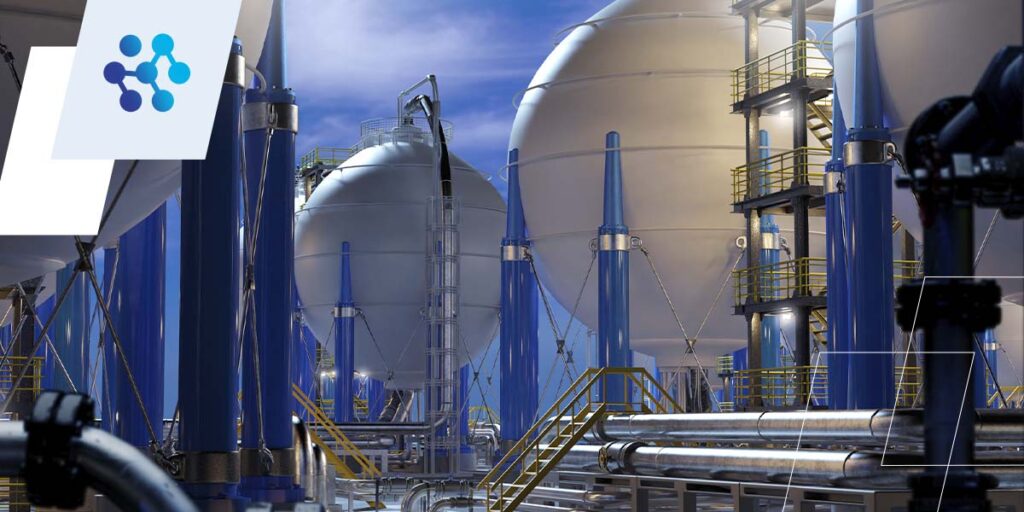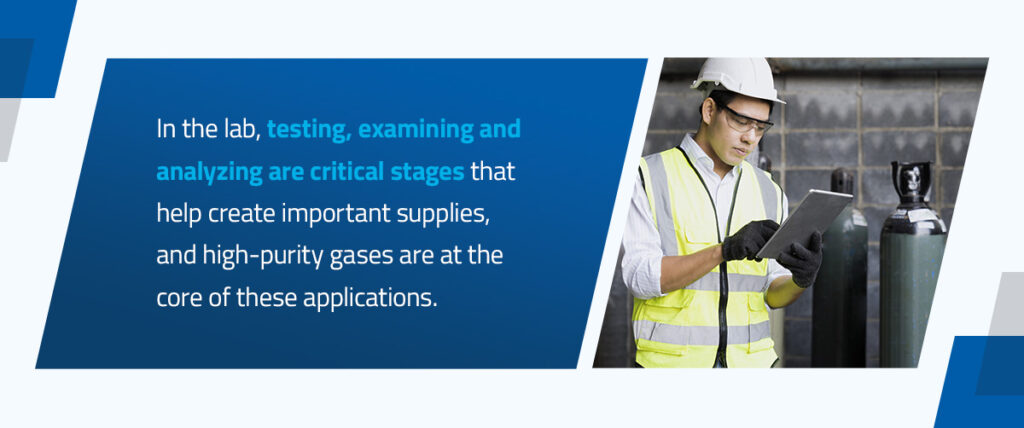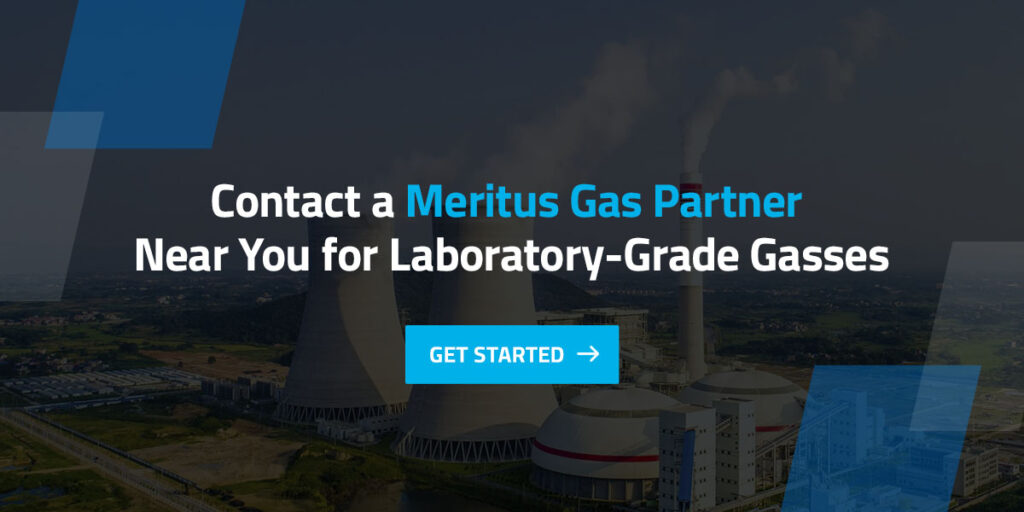

The impact of high-precision gases on laboratory research is undeniable — they play a major role in enabling researchers to conduct important experiments and create life-saving medicines and equipment. Learn about high-purity gases and their importance in lab research here.
The minimum purity of a gas represents how many impurities are in it. One hundred percent purity is impossible because chemical compositions change during manufacturing. In other words, purity in terms of gas refers to the absence of impurity in a particular compound.
Three common gases used in laboratory research include:
Nitrogen (N) is an odorless and colorless gas that is appreciated in many industries for its inert nature. It’s the most abundant naturally occurring gas and has many crucial uses. This nontoxic gas doesn’t react with any other chemicals and is non-poisonous.
Laboratories primarily use nitrogen to maintain an adequate atmosphere for sensitive procedures and specialized equipment. It controls oxygen, temperature and humidity levels in critical areas like mass spectrometers, cell incubators and dry boxes. Operators also use it for mixing, pressurizing, blanketing and purging.
Nitrogen prevents delicate items from reacting with the oxygen in the air, which can cause decay. It’s commonly used in blister packs to preserve pharmaceuticals during transportation and storage. It’s also used in mass spectrometry experiments in the instrumental analysis field to identify unknown compounds and study their reactivity and structure. Another typical use for nitrogen is leak checking. Researchers can use it as a pressurizing agent to find leaks in pipes, tanks and vessels.
Different industries require varying purities of nitrogen. For example, the pharmaceutical industry typically uses ultra-high purity (UHP) nitrogen, which has a gas concentration of 99.999%. This level of purity is particularly useful in chromatography applications where nitrogen is used as a carrier gas. The cryogenics field uses liquid nitrogen to preserve biological samples.
Oxygen (O) is a common green oxidizing agent. Various labs use it in different forms. Chemists typically use it in a synthetic air form, which consists of about 10% oxygen combined with nitrogen. This mixture prevents combustion, which is a possibility with pure oxygen.
Lab operators also use oxygen to manufacture chemicals in fermenters. In these cases, industrial-grade pure oxygen supplies are used to enrich the internal environment of cell cultures, enhancing growth rates. It’s also used in the production of textiles, steel and plastics.
Oxygen’s uses keep expanding. A recent study revealed that oxygen paired with copper can be used to create life-saving drugs at a fraction of the cost. Researchers used oxygen as a reagent and copper as a catalyst, which broke down and converted carbon bonds into amines. Typically, companies use expensive metals to fulfill this purpose, resulting in expensive medications.
Carbon dioxide (CO2) is similar to nitrogen in its inert properties. It’s an excellent general-purpose gas used in blanketing and packaging, which are vital for most lab work. Lab researchers use it in the gas phase for incubators or to control the pH of wastewater.
Carbon dioxide is also applied as a supercritical fluid that sits at an intermediate state between liquid and gas. In this state, quality carbon dioxide gas is pivotal for organic compound extraction.
Another key use of carbon dioxide is “micronization,” which allows operators to produce tiny particles of active medicinal substances. Biology researchers can use CO2 for cell cultivation in a lab, while other industries use it for gas chromatography or pH regulation.

In the lab, testing, examining and analyzing are critical stages that help create important supplies, and high-purity gases are at the core of these applications. High-precision gases come in different grades for various works in this field. Here are four typical laboratory uses for high-purity gases:
Impurities can cause problems with laboratory instruments and result in inaccurate results. Lab researchers generally use high-purity gases because they have lower levels of impurities. These gases are also referred to as instrument-grade gases and typically have a 99.999 percent purity.
High-precision gases minimize noise and baseline drifting while also lowering background interference. These benefits offer operators increased sensitivity, which results in accurate analysis.
Some instruments are prone to damage from impurities, so high-purity gases extend their life. Common instrument-grade gases include:
The two most commonly used gases for chromatography are grade 5.5 industrial helium and industrial-grade hydrogen gas products, but other gases like nitrogen and argon are applied as carriers. Helium and hydrogen have a better flow rate and are compatible with most detection systems.
Different detection systems require varying mixtures of carrier gas. Generally, high-purity gases with low oxygen levels are best.
Laboratories have sensitive equipment, and operators perform delicate procedures. The atmosphere needs to be maintained at all times, or the equipment and procedures can quickly become health or fire hazards.
Pure oxygen can cause other flammable materials to explode and burn rapidly. Atmospheric control is essential to prevent fires when working with flammable chemicals or equipment. Nitrogen is the main gas that maintains the laboratory atmosphere and controls oxygen levels.
Evaporative light scattering (ELS) detection uses UV radiation to detect non-UV-absorbing compounds. ELSDs typically use high-pressure liquid chromatography to accurately identify samples that aren’t absorbing UV.
ELSDs require an inert gas to convert the wash fluids into a spray — nitrogen is typically the common choice. The operator heats the nitrogen spray to evaporate the tested samples. Clean inert gas is preferred because other mixes require the removal of oil and water.
Contact a Meritus Gas team expert to find the best gas products for your laboratory needs.
Laboratory gases help operators perform important research, but they can also threaten safety. Without proper measures, gases can pose risks such as toxicity and rapid combustion.
Since most laboratories use inert gases to maintain a stable atmosphere, explosions aren’t a common hazard. However, some gases, like carbon dioxide, require specialized safety measures. Installing gas sensors keeps operators safe by allowing for constant monitoring of gas levels. These devices can pick up excess levels of harmful gases and detect leaks.
Here are some of the top safety tips for working with gas in a laboratory:
It’s a good idea to put up a compressed gas safety poster in your lab as a reminder of the safety measures.

At Meritus Gas Partners, we understand the impact of high-precision gases on laboratory research, offering decades of experience to help you find the right products for your laboratory. Our partners have extensive selections of safety-compliant high-purity gases, including nitrogen, oxygen and carbon dioxide.
We can save you money and time by helping you select the right combination of gases. Visit one of our branches or contact us for expert advice on high-precision gases today.